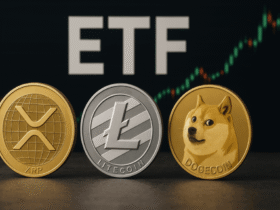In predictive markets, the majority expectation is that the FED will make a new cut.
The president of the FED has shown caution in the face of various macroeconomic data.
The month of October brought with it a reduction of 25 basis points in interest rates by the United States Federal Reserve (FED). And now, after the new range was set at 4% annually, the gaze of the bitcoin (BTC) market is positioned on the institution’s next appointment.
Specifically, Investors’ attention is focused on the meeting scheduled for December 10, 2025in which the possibility of a new cut is anticipated.
Jerome Powell, chairman of the FED, has attempted to temper market expectations. In his statements, he assured that another cut “is not a foregone conclusion.” As reported by CriptoNoticias, this suggests that within the Federal Open Market Committee (FOMC) there are “strong differences of opinion” about the next steps.
The most relevant factor of uncertainty, according to Powell, is the partial shutdown of the US government, which has delayed the publication of essential macroeconomic data. Among them are employment and spending reports. This lack of information, he explained, could alter the reading of real economic conditions and, therefore, complicate decision making.
Impact of government shutdown and trade tensions
The Government Shutdown has created what some economists call a “data vacuum.”. Guillermo Fernandes, Venezuelan bitcoin investor, entrepreneur and cryptocurrency consultant, told CriptoNoticias that this situation “has created a data vacuum, especially due to the lack of complete employment reports.
This is a situation that forces the FED to be cautious, also taking into account that the institution is usually a couple of weeks behind with its metrics. Additionally, trade tensions arising from Trump’s proposed tariffs could fuel inflation, offsetting the cuts.
Fernandes’ words reflect the complexity of the current panorama. A labor market showing signs of cooling—unemployment reached 4.3% in August— and a context of inflation that is still around 3% annually.
The partial government shutdown has led to federal layoffs, further weakening employment numbers, a key element in the evaluation of monetary policy.
In predictive markets there are signs of cuts
As the FED analyzes its next steps, predictive markets offer an immediate reading of collective expectations. On platforms such as Polymarket, one of the most active and with a success rate close to 90%, participants are mostly betting on a new rate cut in December.
The most likely scenario is a reduction of 25 basis points (bps), which It reached an 80% probability at the end of October, but today it is at 69%as seen in the following graph.


The option of no changes in the rate increased to 29%, after having hit minimums in the same month. Meanwhile, the possibility of a more aggressive cut, of 50 basis points or more, barely represents 2.1%, and that of a rate increase remains almost zero, at 1.1%.
Similar behavior is observed on Kalshi, another New York-based predictive marketplace. There, the probability of a 25 bps cut stands at 68%, while keeping rates unchanged gains ground with a 30% probability.


During September and October, The cut scenario exceeded 70%, but Powell’s statements have caused a rebalancing of bets.
CME Group data and its market reading
According to the CME Group’s FedWatch, the main financial derivatives market, operators contemplate two main scenarios after the December meeting.
At the moment, 68% of the probabilities favor a cut of 25 basis pointswhile 31.1% consider that the FED will keep the rate unchanged in its current range.


This reading reinforces the idea that, although the consensus continues to lean towards a reduction, the margin of uncertainty has widened in the face of incomplete data and the prudence of the president of the FED.
CME indicators tend to reflect changes in market sentiment early, so the recent rise in bets on maintaining rates may be a preview of a tighter debate within the monetary committee.
The market’s view of the cuts
The outcome of December is not only relevant for traditional markets. In the digital asset sector, the relationship between interest rates and bitcoin price has historically been significant.
When rates fall, credit becomes cheaper, making it easier to access liquidity and can boost investment in assets considered “risky”, such as BTC.
“If there is a cut in December, bitcoin could rebound between $115,000 and $120,000, driven by liquidity and correlation with technology stocks,” Fernandes projects.
He also mentioned the possibility of a “Santa Claus rally“, a term used in financial markets to describe the price increase that usually occurs during the last weeks of the yeardriven by seasonality, lower volatility and an increase in risk appetite.
The December 10 meeting It will be decisive not only for the bond and stock markets, but also for the immediate future of bitcoin, which closely follows Powell’s every word as a thermometer of global risk appetite.






Leave a Reply